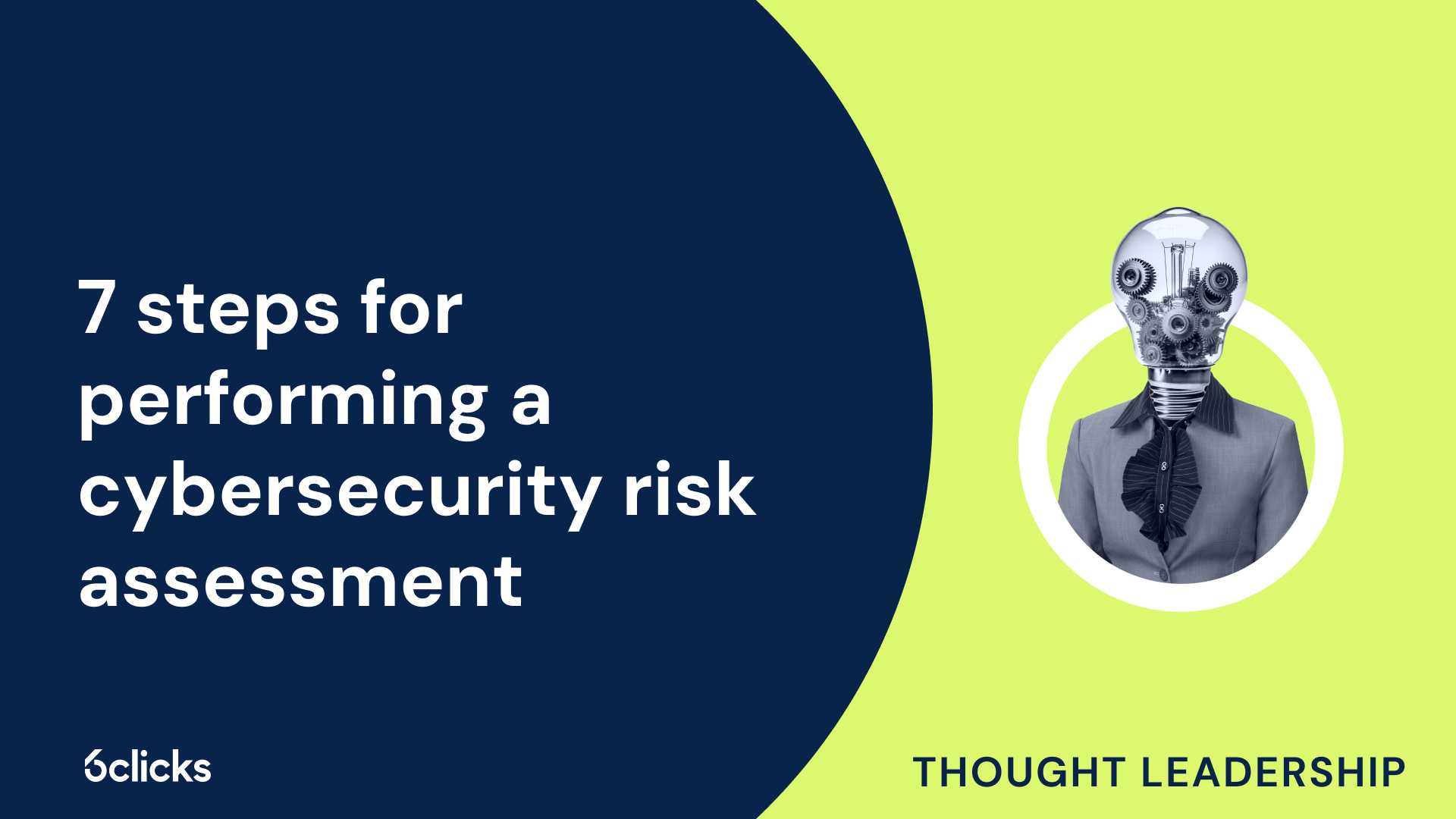Cybersecurity is a critical aspect of an organization’s strategic management. With their increasing dependence on digital infrastructure and the growing number of more sophisticated cyber threats, it is imperative for organizations to proactively manage their cybersecurity risks to uphold data privacy and security, maintain regulatory compliance, and achieve operational resilience.
A cybersecurity risk assessment enables organizations to systematically identify and address risks associated with information systems and data. In this article, we will discuss how organizations can effectively implement the process of cybersecurity risk assessment. We will also take a look into 6clicks’ IT risk management solution.
What is a cybersecurity risk assessment?
At its core, cybersecurity risk assessment aims to understand the potential threats and vulnerabilities that could negatively impact an organization's operations, assets, and reputation. It is the continuous process of identifying, analyzing, and evaluating cyber and information security risks and prioritizing them based on their likelihood and impact. By assessing these risks, organizations can implement appropriate controls and strategies to mitigate them, ensuring the resilience and security of their digital operations.
What are the benefits of cybersecurity risk assessments?
As part of an organization's overall risk management strategy, a cybersecurity risk assessment fosters:
- Improved security posture: Proactively identifying vulnerabilities within their systems, networks, and processes allows organizations to implement necessary security measures to prevent, mitigate, or eliminate threats and reduce the likelihood of security incidents
- Regulatory compliance: Risk assessment facilitates compliance with the cybersecurity risk management requirements of various industry standards and regulations such as the Digital Operational Resilience Act (DORA), NIST CSF, and ISO 27001
- Resource allocation and cost savings: By assessing the likelihood and potential impact of cybersecurity risks, organizations can effectively allocate efforts and resources to mitigate the most critical risks first. Risk assessment can also save organizations significant costs associated with security incidents, system downtime, regulatory fines, and reputational damage.
- Business continuity: Performing regular risk assessments allows organizations to continuously improve security measures to keep up with evolving threats, therefore bolstering their capability to maintain critical operations in case of disruptions
- Stakeholder confidence: Demonstrating a commitment to cybersecurity through regular risk assessments can enhance trust among customers, regulators, and stakeholders and provide organizations with a competitive advantage
In addition, cybersecurity risk assessment supports effective decision-making. Risk assessment findings provide valuable information that can help organizations make informed decisions about resource allocation, risk tolerance, and strategic planning, enabling them to balance security requirements with business objectives effectively.
Components of cybersecurity risk assessment
Several key components make up the process of cybersecurity risk assessment. They include:

- Asset identification and classification – Define assets such as hardware, software, data, networks, and devices
- Threat identification – Determine potential threats such as cyberattacks, natural disasters, system malfunction, and more
- Vulnerability identification – Vulnerabilities include weaknesses in systems and processes that can be exploited by threats
- Risk analysis – A measurement of the likelihood and impact of a risk
- Risk scoring – The overall rating of a risk (low, medium, or high) based on its likelihood and impact
- Risk treatment plan – Propose actions and security measures for mitigating or remediating risks. These can include implementing security policies, conducting employee training, and establishing technical controls such as firewalls and data encryption.
- Documentation and reporting – Document and communicate the findings of the risk assessment in a comprehensive report
How to perform a cybersecurity risk assessment
The process of cybersecurity risk assessment involves several steps:

1. Create a core assessment team
The first step in conducting a cybersecurity risk assessment is to assemble a core assessment team. This team typically includes key personnel such as the CEO, IT manager, and heads of relevant departments. The team is responsible for leading the assessment process, compiling the findings, and making recommendations for improvement. By involving representatives from various departments, the assessment process can benefit from diverse perspectives and expertise.
2. Determine the scope of the assessment
Defining the scope of the risk assessment is crucial. This involves deciding whether the assessment will cover the entire organization or specific areas such as business units, locations, or processes. Clear scoping helps in focusing efforts and resources on the most critical areas. Engaging stakeholders, such as vendors and third-party partners whose activities fall within the scope, is essential to gather comprehensive information about processes, assets, and potential risks.
3. Conduct an asset inventory
An asset inventory involves identifying and valuing critical assets such as hardware, applications, users, and data storage systems. Mapping data flows within the organization and with third-party services is also essential. This step helps in understanding the organization’s attack surface and identifying potential vulnerabilities. Categorize assets based on their importance, such as critical, sensitive, or non-critical.
4. Identify security threats and vulnerabilities
This step involves executing various processes such as threat modeling, vulnerability scanning, manual penetration testing, and analyzing historical data such as past incidents and industry-specific threat intelligence reports to identify common threat vectors. It also involves reviewing existing security policies and procedures and conducting a security gap analysis to compare the organization’s current security posture with industry standards.
5. Analyze risks and determine potential impact
Risk analysis involves evaluating risks that arise from identified threats and vulnerabilities and determining their potential impact on business operations, financials, reputation, and compliance. This can be done by categorizing risks into levels such as high, medium, and low based on their severity and likelihood of occurrence. Understanding the impact helps in prioritizing remediation efforts and allocating resources effectively. Organizations can use risk matrices to visualize and compare the likelihood and impact of various risks.
6. Document and report findings
Documentation is key to a transparent and effective risk assessment. Record the entire process, findings, and recommendations by creating a risk assessment report. A well-documented report helps in communicating the identified risks, their potential impacts, and recommended remediation measures to stakeholders. The report should also outline the risk treatment plan, prioritizing actions based on the severity and likelihood of risks.
7. Implement remediation measures
Finally, address the identified risks by implementing the actions and security measures contained in the risk treatment plan. These can include deploying technologies such as antivirus software and automation tools, enforcing controls like access management, improving security policies and procedures, and supporting risk management initiatives through security awareness training. Continuous monitoring and improvement of security controls and mitigation strategies are essential to maintaining a robust security posture.
Overall, regular risk assessments, continuous monitoring, and proactive remediation are key to safeguarding an organization’s valuable assets and ensuring the continuity of its operations.
Simplify cybersecurity risk assessments with 6clicks
The 6clicks platform equips organizations with powerful IT risk management, asset management, control management, and reporting and analytics capabilities.
Build custom registers for your assets and perform an asset inventory. Utilize ready-to-use risk libraries to expedite risk identification then streamline your cybersecurity risk assessment with comprehensive risk registers where you can store, manage, and evaluate your identified risks.
Use custom fields to assess and categorize risks based on likelihood, impact, and overall risk rating. Then, create risk treatment plans, link controls to risks, and assign mitigation actions to team members. On the other hand, 6clicks’ Controls module allows you to put in place your security controls and assign control responsibilities and tasks to key personnel.
Lastly, leverage comprehensible risk matrices and extensive risk register reports to track the progress of risk assessments and treatment plans, extracting valuable insights to inform decisions.
6clicks also streamlines third-party risk management through turnkey vendor risk assessment templates and custom vendor onboarding forms. You can then report, track, and action issues and incidents associated with third parties using 6clicks’ Issue & Incident Management solution.
Explore the complete features of the 6clicks platform.
Frequently asked questions
Why is a cybersecurity risk assessment important?
By evaluating and assigning remediation measures to cybersecurity risks, organizations can address threats and vulnerabilities before they can be exploited and lessen the likelihood of incidents, thereby protecting their assets, operations, and stakeholders and ensuring compliance with security requirements from industry standards and regulations.
What are the steps for performing a cybersecurity risk assessment?
To start assessing your organization’s cybersecurity risks, first you need to assemble a team who will oversee the process. You must also set the scope for the assessment. Then, you can proceed to identify potential threats and vulnerabilities, analyze risks and their perceived impacts, and then implement risk mitigation measures. Assessment findings must also be documented and communicated to stakeholders.
What are some regulations with cybersecurity risk assessment requirements?
The European Union’s Digital Operational Resilience Act (DORA) and the U.S. Cybersecurity Maturity Model Certification (CMMC) are some examples of regulatory frameworks with specific requirements for risk assessment, incident reporting, and other cybersecurity risk management processes.
Written by Jami Samson
Jami is a seasoned Technical Writer at 6clicks, where she harnesses her extensive experience in domains such as information technology, artificial intelligence, and GRC to craft high-quality content. Having worked in the marketing field since 2017, she has established a solid background in copywriting and content writing and is skilled in translating complex topics into informative and engaging pieces. Apart from writing, Jami is also passionate about music.











